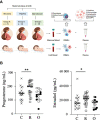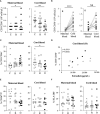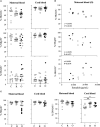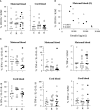Plasticity of natural killer cells in pregnant patients infected with SARS-CoV-2 and their neonates during childbirth
- PMID: 35911747
- PMCID: PMC9335005
- DOI: 10.3389/fimmu.2022.893450
Plasticity of natural killer cells in pregnant patients infected with SARS-CoV-2 and their neonates during childbirth
Abstract
The COVID-19 pandemic has occurred due to infection caused by the SARS-CoV-2 coronavirus, which impacts gestation and pregnancy. In SARS-CoV-2 infection, only very rare cases of vertical transmission have been reported, suggesting that fetal immune imprinting due to a maternal infection is probably a result of changes in maternal immunity. Natural killer (NK) cells are the leading maternal immune cells that act as a natural defense system to fight infections. They also play a pivotal role in the establishment and maintenance of pregnancy. While peripheral NK cells display specific features in patients infected with SARS-CoV-2 in the general population, information remains elusive in pregnant mothers and neonates. In the present study, we analyzed the characteristics of NK cells isolated from both neonatal umbilical cord blood and maternal peripheral blood close to the time of delivery. Phenotype and functions were compared in 18 healthy pregnant women and 34 COVID-19 patients during pregnancy within an ongoing infection (PCR+; N = 15) or after recovery (IgG+PCR-; N = 19). The frequency of NK cells from infected women and their neonates was correlated with the production of inflammatory cytokines in the serum. The expression of NKG2A and NKp30, as well as degranulation of NK cells in pregnant women with ongoing infection, were both negatively correlated to estradiol level. Furthermore, NK cells from the neonates born to infected women were significantly decreased and also correlated to estradiol level. This study highlights the relationship between NK cells, inflammation, and estradiol in patients with ongoing infection, providing new insights into the impact of maternal SARS-CoV-2 infection on the neonate.
Keywords: COVID-19; SARS-CoV-2; natural killer cells; neonates; pregnancy.
Copyright © 2022 Carbonnel, Daclin, Tarantino, Groiseau, Morin, Rousseau, Vasse, Hertig, Kennel, Ayoubi and Vieillard.
Conflict of interest statement
The authors declare that the research was conducted in the absence of any commercial or financial relationships that could be construed as a potential conflict of interest.
Figures





Similar articles
-
The effect of coronavirus infection (SARS-CoV-2, MERS-CoV, and SARS-CoV) during pregnancy and the possibility of vertical maternal-fetal transmission: a systematic review and meta-analysis.Eur J Med Res. 2020 Sep 4;25(1):39. doi: 10.1186/s40001-020-00439-w. Eur J Med Res. 2020. PMID: 32887660 Free PMC article.
-
The legacy of maternal SARS-CoV-2 infection on the immunology of the neonate.Nat Immunol. 2021 Dec;22(12):1490-1502. doi: 10.1038/s41590-021-01049-2. Epub 2021 Oct 6. Nat Immunol. 2021. PMID: 34616036
-
Perinatal transmission of SARS-CoV-2 and transfer of maternal IgG/neutralizing anti-SARS-CoV-2 antibodies from mothers with asymptomatic infection during pregnancy.Infection. 2022 Feb;50(1):131-137. doi: 10.1007/s15010-021-01650-5. Epub 2021 Jul 7. Infection. 2022. PMID: 34232457 Free PMC article.
-
Single-cell immunophenotyping of the fetal immune response to maternal SARS-CoV-2 infection in late gestation.Pediatr Res. 2022 Apr;91(5):1090-1098. doi: 10.1038/s41390-021-01793-z. Epub 2021 Nov 8. Pediatr Res. 2022. PMID: 34750520 Free PMC article.
-
Coronavirus Diseases in Pregnant Women, the Placenta, Fetus, and Neonate.Adv Exp Med Biol. 2021;1318:223-241. doi: 10.1007/978-3-030-63761-3_14. Adv Exp Med Biol. 2021. PMID: 33973182 Review.
Cited by
-
Sex bias in tumor immunity: insights from immune cells.Theranostics. 2025 Mar 31;15(11):5045-5072. doi: 10.7150/thno.106465. eCollection 2025. Theranostics. 2025. PMID: 40303343 Free PMC article. Review.
-
Mild/Asymptomatic Maternal SARS-CoV-2 Infection Leads to Immune Paralysis in Fetal Circulation and Immune Dysregulation in Fetal-Placental Tissues.bioRxiv [Preprint]. 2023 May 11:2023.05.10.540233. doi: 10.1101/2023.05.10.540233. bioRxiv. 2023. PMID: 37214938 Free PMC article. Preprint.
-
Maternal SARS-CoV-2 impacts fetal placental macrophage programs and placenta-derived microglial models of neurodevelopment.J Neuroinflammation. 2024 Jun 25;21(1):163. doi: 10.1186/s12974-024-03157-w. J Neuroinflammation. 2024. PMID: 38918792 Free PMC article.
-
Identification of natural killer markers associated with fatal outcome in COVID-19 patients.Front Cell Infect Microbiol. 2023 Jun 5;13:1165756. doi: 10.3389/fcimb.2023.1165756. eCollection 2023. Front Cell Infect Microbiol. 2023. PMID: 37342247 Free PMC article.
-
Mild/asymptomatic COVID-19 in unvaccinated pregnant mothers impairs neonatal immune responses.JCI Insight. 2023 Sep 12;8(19):e172658. doi: 10.1172/jci.insight.172658. JCI Insight. 2023. PMID: 37698937 Free PMC article.
References
-
- Jafari M, Pormohammad A, Sheikh Neshin SA, Ghorbani S, Bose D, Alimohammadi S, et al. Clinical characteristics and outcomes of pregnant women with COVID-19 and comparison with control patients: A systematic review and meta-analysis. Rev Med Virol (2021) 31(5):1–16. doi: 10.1002/rmv.2208 - DOI - PMC - PubMed
Publication types
MeSH terms
Substances
LinkOut - more resources
Full Text Sources
Medical
Miscellaneous

